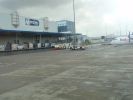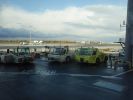

One of the most interesting ground operations is a pushback. Once the airliner is loaded, refuelled, when all the passengers are onboard, when the doors are sealed, and when the pilots obtain the necessary clearance, it's time to start moving the aircraft from the gate through taxiways onto the runway and finally to the air. Most airliners park near the terminal building, so they will need to back up a bit before starting to taxi forward. But this is not as easy as simply using reverse gear in your car would be.
While jetliners are capable of reverse thrust, they do not use it to move away from the terminal building. Thrust reversers are usually panels that can be extended behind the engines in order to bounce forward the high-speed hot jet stream exhausting from the engine. Thrust reversers are usually only used just after touchdown to slow the airliner down, because they are the most effective way of slowing the airliner. The main reason for not using reverse thrust instead of pushback is that it's not safe when there are obstacles in front of the aircraft, because the air with all the small rocks and other debris from the ground would be shot onto the terminal building. Thrust reversers are also very noisy - they cause the sudden increase in noise level that you hear shortly after landing.
This is why airports use special pushback tractors (sometimes called tugs) that will push the airplane back a bit, until the aircraft can start turning and moving forward on its own. Older pushback tractors need to connect the airliner's nose wheel to the tractor using a towbar in order to push the airplane back. The towbar is a bar of metal with a wheel in the center (so the towbar can be towed behind the tractor even without a plane supporting it on the other end). Each aircraft uses a different type of towbar, because the design of the nose wheel is usually different and because the weight of each type of aircraft differs a lot too. That's why the airport needs to have many different types of towbars (and several types of tractors) ready. Apart from connecting the towbar to the nose wheel, the ground personnel also has to disconnect the steering of the nose wheel, because they need the nose wheel to move freely. You can see a towbar tractor with a towbar attached on the first picture; it's the low white car behind the conveyor belt and it has an orange bar attached to it. The second picture shows the many types of towbars that airports have in store; they are the yellow and white bars lying on the ground behind the yellow towbar tractor.
Trivia: If you look carefully at the towbar tractor on the first picture, you will have no doubt what was the model for the car that Ripley used in the Aliens movie. Thanks to Peter for realizing this.
Using towbars to push or tow an aircraft has its drawbacks, because it puts a lot of strain onto the nose wheel and because the towbar tractor cannot brake the aircraft if the towbar breaks, so a pilot or a mechanic must be present in the cockpit to brake if the towbar automatically disconnects as a result of being overstressed. Some clever minds then came with an innovation: towbarless tractors, which, as the name suggests, do not use a towbar to connect to the aircraft. Instead, they have special lifting mechanism in the back of the tractor. The towbarless tractor maneuvers itself so it almost surrounds the nose wheel of the aircraft, the nose gear tyre is then attached to a lifting device located in the center of the tractor. The device draws the aircraft onto a platform and lifts the nose wheel a little along with the whole front fuselage. Then the tractor can move with the aircraft as needed and it can even stop the aircraft at all times without the help of anyone in the cockpit. You can see the towbarless tractors, including the lifting mechanism, on the next few pictures.
Most of the tractors have a cabin that can be vertically lifted or lowered, because when towing an aircraft, it needs to be as low as possible in order to drive under the aircraft, and when moving on its own, the driver needs to see the situation on the road in front of the tractor. You can see that on the previous set of pictures.
The tractors on the next set of pictures are moving to position for the pushback and the ground crew are preparing the to attach the airplane's nose wheel to the tractor.
The pilots usually start the engines during or shortly before pushback. Once the airplane is at the spot from which it can move on its own, the ground crew will disconnect the tractor from the airplane, signal the pilots (either using radio or visually) that the equipment has been removed, and once the pilots receive clearance from the ground controllers, they can start taxiing towards their assigned runway.
Pushback tractors are capable of not only pushing the planes back, but also of towing them. This is done every time when it is not possible or efficient to move the aircraft using its own engines, perhaps to a hangar, between gates, or pretty much anywhere else. Towbar tractors are capable of moving an aircraft at about 15 kilometers per hour maximum, but the towbarless tractors can achieve twice that if needed.
Copyright notice: Text and images copyright by Michal Řeháček.